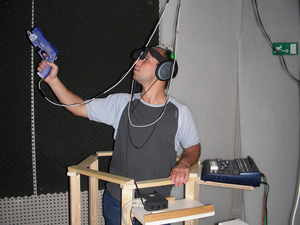LocaMethods: Localization of Virtual Sound Sources
Objective
Humans' ability to localize sound sources in a 3-D space was tested.
Method
The subjects listened to noises filtered with subject-specific head-related transfer functions (HRTFs). In the first experiment with new subjects, the conditions included a type of visual environment (darkness or structured virtual world) presented via head mounted display (HMD) and pointing method (head and finger/shooter pointing).
Results
The results show that the errors in the horizontal dimension were smaller when head pointing was used. Finger/shooter pointing showed smaller errors in the vertical dimension. Generally, the different effects of the two pointing methods was significant but small. The presence of a structured, virtual visual environment significantly improved the localization accuracy in all conditions. This supports the idea that using a visual virtual environment in acoustic tasks, like sound localization, is beneficial. In Experiment II, the subjects were trained before performing acoustic tasks for data collection. The performance improved for all subjects over time, which indicates that training is necessary to obtain stable results in localization experiments.
Funding
FWF (Austrian Science Fund): Project # P18401-B15
Publications
- Majdak, P., Goupell, M., and Laback, B. (2010). 3-D localization of virtual sound sources: effects of visual environment, pointing method, and training, Attention, Perception, & Psychophysics 72, 454-469.
- Majdak, P., Laback, B., Goupell, M., and Mihocic M. (2008). "The Accuracy of Localizing Virtual Sound Sources: Effects of Pointing Method and Visual Environment", presented at AES convention, Amsterdam.
